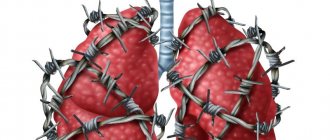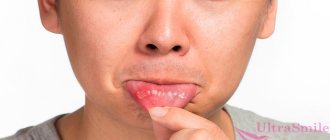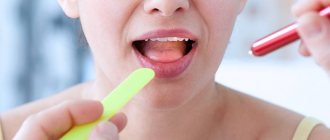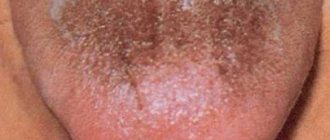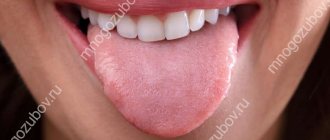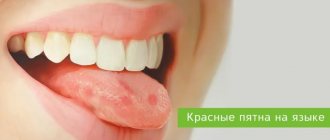The human body is a complex mechanism consisting of a huge number of organs and systems. Several structures are responsible for performing the same function, constantly complementing each other. For example, different organs take part in the digestion process.
Injury
In case of traumatic injury, a kind of capsule is formed in the oral cavity, which is filled with secretions and pathogenic microorganisms. The lights enter the food cavity.
Trauma can cause the gland to become clogged with saliva, leading to the formation of a cyst.
It is not difficult to get such damage; it often occurs as a result of:
- Contact with sharp, chipped teeth.
- Rough food, various metal objects.
- If you hit the jaw, you can injure the mucous membrane of the mouth and tongue.
- In contact with reagents and hygienic devices.
You can get injured while taking medications, eating food, or using dental floss. As a result, the mucous membrane swells and secretions accumulate in it. It can be transparent, bloody or bloody.
The capsule or bubble may burst on its own, without medical intervention. But education, in case of poor immunity, disruption of the body’s natural protective functions, becomes inflamed, which is fraught with consequences.
Candidal stomatitis
Many are accustomed to thinking that stomatitis caused by the Candida fungus virus makes itself felt only through ulcers and rashes that appear on the gums and palate. But in fact, its main symptom is a dense whitish or grayish coating of curd consistency on the tongue. If you try to remove such plaque, you will find blisters underneath that itch, hurt, and bleed. As a rule, small blisters are found around the perimeter of the tongue.
The photo shows candidal stomatitis
Often the disease is provoked not only by weakened immunity, dysbiosis and long-term use of antibiotics, but also by the presence of advanced dental pathologies and lack of proper oral hygiene.
Antihygiene
Violation of the rules of oral hygiene leads to the following problems:
- pathogenic microorganisms accumulate in the mouth;
- they lead to an inflammatory process, thinning the mucous membrane;
- as a result, a purulent formation may appear.
Pathogenic agents, as well as leukocytes, accumulate in the bladder, which indicates the development of inflammation. The formation often bursts on its own, the contents come out. Following the rules of hygiene and installing drainage will help to avoid its reappearance.
Allergic dermatitis
When small blisters appear at the root of the tongue, they are red in color and itch very much, this usually indicates the development of an allergic reaction to food, personal hygiene products (inappropriate brush, mouthwash), and medications.
The photo shows an allergy on the root of the tongue
In such conditions, the muscular organ swells, and the lymph nodes become slightly swollen. In advanced stages, cracks, crusts and erosions can form, and rashes can appear not only in the mouth, but also around the lips and even on the face.
Syphilis
Classified as a venereal disease of bacterial origin. The bacterium infects the lymph nodes, leading to the appearance of hard chancre.
A dense formation appears on its own; other signs may not bother you at all. After a short period of time it disappears, and then the chancre appears again.
Syphilis is dangerous because it leads to the death of the patient if not treated up-to-date.
A course of antibiotic therapy, which is carried out under the supervision of a doctor, will help get rid of the signs of the disease.
It is believed that the formation appears on the genitals, but in the case of oral contact, the chancre can also appear in the oral cavity.
In the human body during normal development there are three pairs of salivary glands
The parotid gland is most often affected by various diseases. There are a number of diseases in which the sublingual and submandibular salivary glands become inflamed. If you do not start treatment on time or undergo inappropriate therapy, then serious complications may occur after such diseases, such as encephalitis, orchitis, meningitis, nephritis, neuritis and pancreatitis. However, do not worry, treatment often gives positive results. To avoid inflammation of the salivary glands, you just need to follow a few recommendations.
Complications after illness
Even common colds and flu lead to similar complications if:
- The person has poor immunity.
- There are metabolic disorders.
- Systemic diseases of internal organs of bacterial origin were diagnosed.
- Measures to treat influenza or ARVI were not taken in a timely manner.
In some cases, the formation in the form of a bubble is an inflamed lymph node. In such a situation, antiviral or antibacterial therapy is required.
Infection
A large number of bacteria accumulate in the oral cavity and cause inflammation. Thinned areas of the mucosa are easily affected by pathogenic microorganisms. As a result, a bubble forms.
Table 1. Associated symptoms and causes of the development of the infectious process:
| Why does the bubble appear: | What are the signs of concern: |
| As a result of untimely or poor-quality surgical intervention. | Against the background of an inflammatory or infectious process in the human body, body temperature rises. |
| Failure to follow doctor's recommendations after tooth extraction or other dental procedures. | Intoxication of the body is observed, general weakness worries, performance and appetite decrease. |
| The infection also enters the body if hygiene rules are not followed. | In the area of inflammation, the bubble, redness of the mucous membrane is observed, the patient complains of unpleasant sensations that intensify when eating. |
Infection leads to various consequences and is the cause of atrophic changes. Ulcers appear in the mouth, on the mucous membrane, which disrupts the usual process of eating.
If a person has signs of an oral infection, he should consult a doctor. Refusal of medical care can lead to sepsis and other serious complications.
Infectious pathologies
Almost all children aged 3-7 years get chickenpox, during which you can easily find blisters not only on the body, but also in the mouth, usually located at the root of the tongue, as well as rashes closer to the throat, filled with a yellowish liquid. The disease can in rare cases be found in adults, but the older generation suffers it much more severely, almost always with high body temperature and severe malaise.
With chickenpox, pimples can be not only on the body, but also on the tongue
There is another childhood pathology - scarlet fever. This disease manifests itself in almost the same way as chickenpox, but it also causes swelling of the larynx.
Oncology
It is no secret that these types of formations have specific symptoms. With malignant tumors, a bubble appears in the oral cavity that is prone to growth.
Other associated manifestations:
- the mucous skirt darkens, which is noticeable during a visual examination and collection of material for research;
- the tumor rapidly increases in size, grows and affects the tissue of the lymph nodes;
- a person loses weight, his performance decreases, and the skin acquires a peculiar, earthy tint.
Oncology manifests itself late; in the early stages it occurs without severe symptoms, which is its main danger.
What is
A lump is a formation of varying size, formed from the upper layers of the mucous membrane. The neoplasm may be white or red, as well as a bluish tint. Inside the cavity there is content consisting of lymph, blood clots, pus or pathologically altered cells.
A lump under the tongue often indicates a disease. The cause is identified based on external signs, examination of the tumor, and histological examination.
Treatment depends on the provoking factor and type of formation. Antibiotics and antiseptics are prescribed. Sometimes surgery is required.
There may be several reasons for the formation of a tumor. Most often this is damage to the mucous membrane or the development of other diseases. That is why it is important to promptly establish the cause of its occurrence, before the pathological process spreads to other tissues of the oral cavity.
Sometimes a lump in the area of the hyoid frenulum may indicate a mandibular ridge (torus).
Bone hyperplasia is in most cases benign and requires treatment only if it interferes with the installation of prostheses.
Dentist
Novikova Olga Alexandrovna
8 years of experience
Treatment is carried out after diagnostic testing and exclusion of malignancy, since a lump in the sublingual area may appear as a result of the development of oncology.
Food and medicine
Some foods and medications cause a bubble to appear under the tongue. What are the possible reasons:
- Aggressive substances thin the oral mucosa.
- Rough food injures and damages sensitive membranes.
Alcohol, nicotine, and aggressive substances cause serious damage to the mucous membrane and can lead to the formation of cysts and other problems. Long-term, systematic smoking is regarded as one of the causes of cancer.
Treatment and removal methods
The treatment regimen is drawn up depending on what factors caused the anomaly. But treatment is necessary so that the acute stage of the disease does not develop into the chronic phase. If this happens, the exacerbation will recur from time to time. This form of the disease is more difficult to treat. If necessary, laser treatment of gums should be carried out on time. A healthy oral cavity is the key to the overall well-being of the body.
- The doctor selects medications based on the underlying pathology. The initial manifestations of the disease are successfully eliminated with medications and local applications. According to indications, medications are recommended that stimulate saliva production. This may be Galantamine, Pilocarpine, Potassium Iodide. To maintain general condition, the doctor selects means to stimulate the immune system.
- Serious blockage of the salivary glands is eliminated by mechanical cleaning of the ducts. Today, sialoscopy, a minimally invasive procedure for grinding mineral deposits, is widely used.
- Purulent papules are opened, after which the exudate is removed. Surgical technologies such as galvanocaustics, electrocoagulation, cryodestruction, laser beams, and radio waves are used.
- Sanitation of the oral cavity to accelerate the regeneration of damaged tissue includes rinsing with Chlorhexidine, Furacilin, Rotokan, Miramistin.
To prevent pathology, you need to regularly carry out hygiene procedures with a brush and toothpaste. In addition, floss and irrigator should be used. It is necessary to visit the dentist every six months, and other doctors when the initial symptoms of the disease appear.
Ranula
This is a benign, cystic formation that occurs for several reasons. Often a cyst is a consequence of a gland being blocked by saliva.
Associated symptoms:
- the formation does not cause pain or serious discomfort;
- at the initial stage it does not interfere with eating, it increases in size slowly;
- there are no accompanying symptoms: body temperature is stable, no intoxication is observed;
- with a cyst, a person pays attention to increased salivation, which is often disturbing when a bubble appears under the tongue.
Upper respiratory tract diseases
If red round blisters appear on the tongue closer to the throat, the throat itself swells, itches and becomes inflamed, the body temperature begins to rise, the breath becomes foul, and the person cannot eat without pain, then based on these symptoms one can suspect a sore throat and pharyngitis. With pharyngitis, the voice “sits down” and it becomes very difficult to talk.
Throat diseases can cause pathology
A similar symptom is recorded in the following conditions: syphilis, tuberculosis, HIV, oncology, vitamin deficiency, diabetes mellitus, pemphigus, angisarcoma.
Diagnosis of the disease
The diagnostic procedures are as follows:
- It all starts with collecting anamnesis, the doctor interviews the patient for complaints.
- Examines his oral cavity and may take a swab from the throat.
- Writes out directions for blood and urine tests.
If necessary, prescribes other specific procedures that will help diagnose the patient and differentiate the pathology.
Table 2. What else is carried out as part of the diagnosis:
| The secretion is collected laparoscopically: | The procedure helps to differentiate the pathology. Using a laparoscope, doctors take a certain amount of contents from the formation for analysis. | The procedure helps in diagnosis; it is also performed to remove small tumors. |
| Histological examination: | The material is taken to the laboratory and processed in a special way. | The study helps in diagnosing oncological formations and determines the nature of the tumor. |
| Biopsy: | A study is carried out if, at the time of the operation or under other circumstances, the doctor suspects the presence of oncology. | A biopsy is not performed as part of prevention, but this test is considered inaccurate for a number of reasons. |
The doctor may prescribe a puncture; in this case, a secretion is also collected, which is sent to the laboratory for testing.
Comments
A pimple appeared on my tongue and it was very itchy. Maybe I should drink something for my allergies? Or go straight to antibiotics?
Maria (12/11/2020 at 12:18 pm) Reply to comment
- If you suspect an allergy, it is still permissible to take an antihistamine (Erius, Zodak, Suprastin). But antibiotics, antifungal and antiviral tablets should never be used without the prescription of a specialist. Although the symptoms of conditions that cause blisters on the base of the tongue or closer to the throat are similar, each is treated differently. So, if you start taking antifungal medications for a herpetic infection, you can further aggravate the situation.
Editorial staff of the portal UltraSmile.ru (12/16/2020 at 09:12) Reply to comment
It’s good if the dentist paid attention to the pathology and advised you to see a therapist. Can a dentist, seeing a problem, recommend donating blood for specific types of diseases?
Dasha (12/18/2020 at 10:00) Reply to comment
Herpes is half the problem, or if you suddenly and carelessly sip hot tea or boiling water. How do you get these blisters out? Firstly, the tongue hurts and eating will be uncomfortable and painful.
Yura (12/18/2020 at 11:38 am) Reply to comment
If there is a minor allergy that causes blisters on the tongue, does it make sense to choose antihistamines? I have noticed this phenomenon in myself more than once, it slowly goes away.
Ruslan (12/18/2020 at 11:42 am) Reply to comment
I recently changed my toothpaste and noticed a rash on my tongue. Could they be a reaction to toothpaste? Please advise what to do in this case, maybe not to risk it and replace it with another?
Lena (12/18/2020 at 11:44 am) Reply to comment
Should you go to an ambulance with this problem? Maybe the doctor will advise something, prescribe some medications? Is it really possible to self-medicate if such a problem suddenly arises?
Masha (12/18/2020 at 11:45 am) Reply to comment
Not long ago I took ice cream out of the freezer, ate it and noticed that blisters appeared on my tongue after eating it. Is this a reaction to dyes and composition or an allergy to cold, tell me how to find out?
Leonid (12/18/2020 at 11:46 am) Reply to comment
Blisters periodically appear on the child’s tongue, but just as mysteriously they go away on their own. After a while this repeats itself. Tell me, could this be due to problems with the gastrointestinal tract?
Anna (02/05/2021 at 09:33) Reply to comment
Wow, there are so many reasons, you won’t immediately understand why, in any case you need to go to a specialist, and you probably won’t figure it out without tests. And if they appear and disappear on their own, is it worth going to the doctor?
Alena (02/05/2021 at 10:01 am) Reply to comment
Sometimes small blisters or pimples appear on the very tip of my tongue, I don’t know what they’re called exactly. They cause slight discomfort, but gradually disappear. There seem to be no health problems. What could it be? Do I need to go to a specialist about this?
Ekaterina (02/05/2021 at 10:03 am) Reply to comment
Tell me, a couple of days ago, my tongue started to burn, as if it had been burned by boiling water, today I noticed small blisters, is this an allergy to something?
Valeria (06/08/2021 at 19:37) Reply to comment
Write your comment Cancel reply
Treatment of blisters under the tongue
Therapy has several directions and depends on the cause of the development of education, it includes:
- Taking antibacterial drugs, in particular antibiotics, is prescribed for inflammatory and infectious processes, when the mucous membrane is affected by pathogens.
- Conducting antiseptic rinses that will help destroy pathogenic agents, antiseptics are often prescribed in the form of solutions.
- Treatment may include cleaning the cavity, removing the formation, and installing drainage. Often the edges of the bladder are cleaned and stitched, which helps prevent relapse.
In general, therapy directly depends on the cause of the development of the pathological process; it is prescribed by a doctor, he selects medications and monitors the dynamics.
Signs of normality and pathology
The tongue is a muscular organ that is responsible not only for our speech and perception of the taste of food, but also often signals problems occurring in the body. In its normal state it is pinkish, the tissue structure is homogeneous. The organ can be covered with a whitish coating (most often in the morning), or colored deposits from food: both types are easily removed with a brush or scraper.
In normal condition, the tongue is pinkish
If spots and blisters of different colors and in different quantities appear on the tongue, this indicates a negative impact on the tissue of external factors, or the occurrence of pathological processes and various diseases in the body1. In this case, the neoplasms can itch, burn, hurt, itch, burst, become covered with a crust and a foul-smelling coating.
We will analyze all the main reasons further.
Rinse
To carry out such procedures, dentists prescribe antiseptic and anti-inflammatory solutions.
Table 3. Names and specifics of medications:
| Chlorhexidine: | It is considered a good antiseptic, which is often used in dentistry as part of sanitation. A clear solution with a bitter taste will not harm the mucous membrane. |
| Stomatophyte: | A herbal drug, alcohol-based, which is prescribed to patients who have undergone surgery. Effective for inflammatory and infectious diseases. |
| Furacilin in solution: | The yellow liquid, which is used for rinsing, has a pronounced antiseptic effect. |
The doctor may prescribe Miramistin or any other antiseptic; aggressive solutions such as hydrogen peroxide are less commonly used, since they can cause damage to the mucous membranes.
Rinsing with herbal solutions has good results, using:
- Chamomile decoction is a natural antiseptic that promotes the death of pathogenic flora.
- Calendula infusion accelerates regeneration processes, promotes healing and restoration of the membranes of the oral mucosa.
- A decoction of oak bark has an excellent astringent effect and promotes the rapid healing of wounds and injuries.
You can also rinse your mouth with propolis tincture; it speeds up recovery and is considered a natural antiseptic. This means it prevents the proliferation of pathogenic microorganisms.
Thermal and chemical burns
Pathology may indicate that a person has consumed too hot foods and drinks. The problem often occurs among smokers, as cigarette smoke can lead to irritation and damage to delicate tissues.
A burn can be caused by eating sour and spicy foods, after which a feeling of “on edge” often appears on the tongue. The problem is also caused by the independent use of various drugs, as well as aggressive agents in folk recipes for the treatment of diseases of the oral cavity (hydrogen peroxide, iodine, potassium permanganate, garlic, alcohol).
A blister may occur as a result of a burn.
As a rule, in such situations, the very tip of the tongue becomes blistered.
Other treatments
In addition to antiseptic solutions, antibacterial drugs can be prescribed. They promote rapid healing of wounds and injuries, and reduce the likelihood of complications.
For a cyst, a different technique is used: a special material is placed into the cavity, which is impregnated with iodine. It is left for several days, then removed and stitched up. Such treatment helps prevent relapse, but even this treatment method cannot completely eliminate it.
If the tumor is oncological, radiation and chemotherapy are often performed. Surgical removal of the formation with excision of the affected tissue is also recommended.
Surgeons recommend opening the bladder cavity, stripping the tissue, removing its contents, and installing drainage (if required). In this case, the risk of complications and relapse is reduced.

